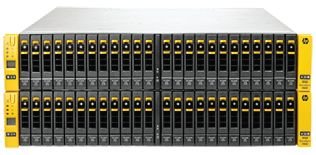The concept is personas. HP introduced it to its 3PAR StoreServ 7000 series in 2012, as a way to apply simple role-based profiles to storage arrays – originally for block and file storage. With the arrival of StoreServ 7440c, HP is upgrading its 3PAR storage operating system to extend this concept to multiple personas. This way, a single array can present itself to different applications as a file, block, or object persona depending on how it’s being addressed.
As HP Storage director of product marketing Vish Mulchand explained to DatacenterDynamics: “You can present via block protocol for VMware (for example, server virtualization) and you can present to a Windows 7 client via the SMB protocol. This file persona allows the array to take on two different personalities, in order to present itself to two different data types.”
HP is calling its new StoreServ model 7440c a converged flash array, meaning it supports a mix of SSD and HDD media best suited to the application it’s being used for. Mixing the two media is nothing new in itself, but with the upgraded 3PAR system with the added object storage persona, admins can optimize how both media types are used – for example, with much more granular fine-tuning of read and write operations and with the aim of extending the life of flash media that can, after all, wear down over time.
There’s another persona that’s hidden away, lurking beneath the surface, Mulchand tells us. It’s the flat backup persona. With this, snapshots of a storage array can be directly mapped onto a backup storage location, without the use of backup software. From VMware vCenter, a storage admin can designate virtual machines or a set of data stores as candidates for backups. Without software intervention, the snapshots are made, moved to the array, and from there to the backup location.
If an admin makes multiple snapshots, Mulchand continues, again from vCenter, using the Express Protect feature, the admin can designate that only the deltas of those snapshots are moved over. “On the backup side, you have the ability then to take all of the data and recreate a full backup,” he says, “even though you’re only storing in increments.”
Typically there are two objectives for large-scale data backup, the second one being cataloguing and indexing for determining file priority during a recovery operation. Traditional data backup software may still be best suited for this purpose, admits HP’s Mulchand, although 3PAR’s new flat backup persona moves the first and most important objective – moving the data – to vCenter Site Recovery Manager, by way of HP OneView.
“The data mover function, because it’s going direct, it’s faster,” he says, “and because we’re doing Express Protect and only copying a small amount of deltas, it’s also a small amount of data.”
Using a service called 3PAR Online Import, customers will be given the option of migrating their data from an existing HP EVA, EMC VNX, EMC Clariion CX4, and now EMC Symmetrix VMAX directly to a 3PAR array, by way of Internet connectivity Fibre Channel, for no additional charge during the first six months of ownership.
“Online Import is an online operation. The host is still writing to the existing array, and while it’s writing, the array data is being transferred,” Mulchand explains. “Now, initially it starts off being behind the moving data, but eventually it catches up. There’s a point at which you can do a cutover via multipathing to the host, to make the new array active.”
This addresses the perennial problem of acts of nature interrupting the backup process, as they’ve been known to do. With two paths leading to the storage array, data is being written through one path while Online Import is moving data through the second path. Once the import is done, and the writes are both synchronized, the paths are switched over.
The new StoreServ 7440c is being offered as part of a retooled StoreServ lineup. It provides a maximum capacity of 3.5 PB at a throughput rate HP clocks at 900,000 IOPS, and is available immediately starting at $78,000. The revamped StoreServ management software will be available December 15.

